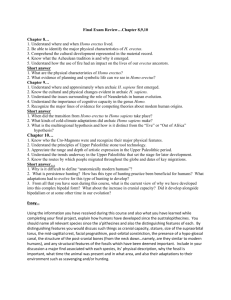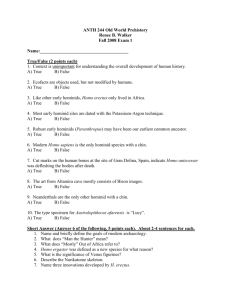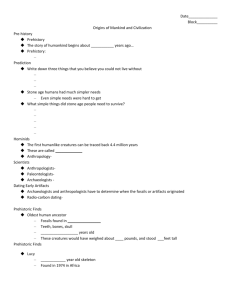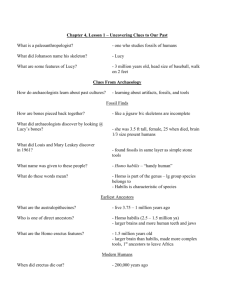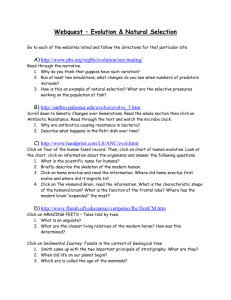Chapter 9 Homo erectus and Contemporaries
advertisement
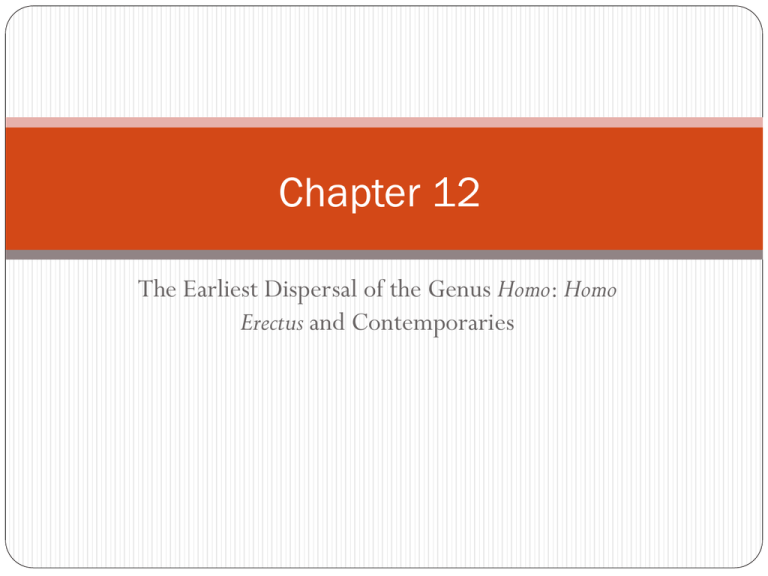
Chapter 12 The Earliest Dispersal of the Genus Homo: Homo Erectus and Contemporaries Introduction The Life and Times of Homo erectus The oldest specimens of H. erectus have been found in East Africa, they’re dated to approximately 1.8 mya. These new East African hominids used the same stone tools as their ancestors. They lived in lakeshores, riversides, forests, and grasslands. They scavenged and ate at least some meat, as evidenced by cut-marked bone. Major Homo Erectus Sites and Localities of Other Contemporaneous Hominids Major Homo Erectus Sites and Localities of Other Contemporaneous Hominids Morphology of Homo erectus Brain size is related to overall body size. Body size dramatically increased compared to earlier hominids. Cranium had a distinctive shape with a thick cranial bone and large brow ridges. Shovel-shaped incisors suggest an adaptation in huntergatherers. Morphology and Variation in Homo erectus Discoveries in East Africa Louis Leakey unearthed a fossil skull at Olduvai. An almost complete skull was discovered in east Turkana. The most complete H. erectus skeleton ever found was uncovered in west Turkana. In Ethiopia, an abundance of Acheulian tools have been found as well as a robust mandible dating to 1.3 m.y.a. East African Homo erectus East African specimens have thinner cranial bones than those found in Asia. Some scientists argue that the African and Asian erectus finds should be classified as separate species. The African and Asian populations are separated by more than one million years. East Lake Turkana, Kenya Nearly complete skull of Homo erectus from East Lake Turkana, Kenya; dated to approximately 1.8 mya. Nariokotome, Kenya WT 15000 from Nariokotome, Kenya: the most complete H. erectus specimen yet found. Olduvai Gorge Location of a very robust skull discovered by Louis Leakey in 1960. Dated at 1.4 mya, the cranial capacity is the largest of all the African H. erectus specimens. The browridge is the largest known for any hominid, but the walls of the braincase are thin. This differs from Asian H. erectus, in which cranial bones are thick. Gona and Daka Key Homo erectus Discoveries from Africa Site Dates (y.a.) Human Remains Bouri 1.0 my Well-preserved cranium Olduvai 1.4 my Partial cranium and a few postcranial pieces Nariokotome 1.6 my Mostly complete adolescent Skeleton E. Lake Turkana 1.8 my One nearly complete cranium and a few postcranial pieces The Dmanisi Hominids The discovery of the Dmanisi materials began in the early 1990s. The Dmanisi crania have similarities to H. erectus, while some characteristics are different from other hominid finds outside of Africa. Dmanisi Crania Dmanisi crania discovered in 1999 and 2001 and dated to 1.8–1.7 mya. Specimen 2282. Dmanisi Crania Dmanisi crania discovered in 1999 and 2001 and dated to 1.8–1.7 mya. Specimen 2280. Dmanisi Crania Dmanisi crania discovered in 1999 and 2001 and dated to 1.8–1.7 mya. Specimen 2700 Dmanisi Cranium Most recently discovered cranium from Dmanisi, almost totally lacking in teeth (with both upper and lower jaws showing advanced bone resorption). Questions Raised by the Dmansi Discoveries Was Homo erectus the first hominid to leave Africa—or was it an earlier form of Homo? 2. Did hominids require a large brain and sophisticated stone tool culture to disperse out of Africa? 3. Was the large, robust body build of H. erectus a necessary adaptation for the initial occupation of Eurasia? 1. Discoveries in Java Eugene Dubois Six sites in eastern Java have yielded all the H. erectus fossils found on this island. Dates range from 1.8 m.y.a. to 1.6 m.y.a. The Ngandong individuals date from 50,000 to 25,000 y.a. If the Ngandong dates are correct it would make Homo erectus and Homo sapiens contemporaries. In Java, no artifacts have been found that can be associated with Homo erectus. Trinil Skullcap The famous Trinil skullcap discovered by Eugene Dubois near the Solo River in Java. This is the first time a fossil human was found outside of Europe or Africa. Discoveries in China Zhoukoudian Cave “Dragon bones” used as medicine and aphrodisiacs were ancient bones. 40 male and female adults and children have been found The site was occupied for 250,000 years. 40% of the bones were from individuals less than 14 years old, 2.6% were from individuals between 50-60 years. Zhoukoudian Composite cranium of Zhoukoudian Homo erectus, reconstructed by Ian Tattersall and Gary Sawyer of the American Museum of Natural History in New York. Reconstructed Cranium of Homo erectus (a) Reconstructed cranium of Homo erectus from Lantian, China, dated to approximately 1.15 mya. (b) Hexian cranium. Key Homo Erectus Discoveries From Asia Dates Site Evolutionary Significance 50,000– 25,000 ya Ngandong (Java) Very late survival of H. erectus in Java 670,000– Zhoukoudian 410,000 ya (China) 1.6 mya Sangiran Most famous H. erectus site; shows some populations well adapted to the cold First discovery of H. erectus; shows dispersal out of Africa by 1.6 mya Africa vs. Asia East Africa Thinner cranial bones Less butressed crania Homo ergaster? Daka discovery Later Homo erectus in Europe Spain and Italy Atapuerca Gran Dolina Ceprano Gran Dolina Ceprano Homo Erectus Cranium From central Italy, provisionally dated to 800,000–900,000 ya. This is the best evidence for Homo erectus in Europe. Key Homo erectus Discoveries from Europe Site Dates (y.a.) Human Remains Ceprano 900–800 ky Well-preserved cranium Gran Dolina 850–780 ky Fragmentary remains 1.75my 4 crania plus a few postcranial remains Dmanisi Time Line for Homo Erectus Discoveries and Contemporary Hominids Chinese Tools From Middle Pleistocene Sites Technological Trends in Homo erectus Expansion of the brain enabled H. erectus to develop sophisticated tools: Biface - stone that was worked on both sides and used to cut, scrape, pound, and dig. Thousands of Acheulian hand axes have been found with remains of large animals. Homo erectus is seen as a potential hunter and scavenger. Small Tools of the Acheulian Industry (a) Side scraper (b) Point (c) End scraper (d) Burin Acheulian Biface A basic tool of the Acheulian tradition. Butchering A Middle Pleistocene butchering site at Olorgesailie, Kenya, excavated by Louis and Mary Leakey who had the catwalk built for observers. Acheulian Tools Acheulian tools, mainly hand axes, found at Olorgesailie in Kenya. Thousands of similar tools were found at-this site. Trends in Homo erectus Homo erectus liked to travel. Stone tools found on the island of Flores, suggest that H. erectus constructed ocean-going vessels. Homo erectus embraced culture as a strategy of adaptation.


